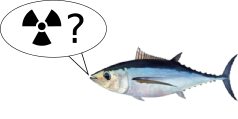Tuna are safe to eat after Fukushima
By Nick Touran, Ph.D., P.E., 2015-04-25 , Bulk by Delvan Neville , Reading time: 3 minutes

The Fukushima nuclear reactor accident released radioactive atoms into the environment. Many of these made it into the ocean and have been found in fish such as Albacore Tuna. Lots of people are concerned about the health effects of eating such tuna. As such, nuclear people get asked questions about it a lot.
The Oregon State University Nuclear Engineering and Radiation Health Physics Department has some world experts in radioisotope biological uptake and is involved in several radiation monitoring programs. Delvan Neville, a graduate student involved in this research, provided the following summary of their measurements, and the health implications. He says:
"The highest concentrations of Cs-137 and Cs-134 I've seen in albacore on our coast so far result in a CEDE (committed effective dose equivalent, which accounts for the type of radiation, the sensitivity of each organ, and how long any ingested Cs is retained in your body) of 18.01 nSv per kg ingested, which works out to about 330,000 kg to equal the normal annual dose in the Pacific Northwest (6 mSv, 3 mSv from natural sources, 3 mSv from mainly medical exposures). About 1/3rd of the dose from said highest Cs level albacore is from pre-Fukushima weapons fallout. The average american eats about 7 kg of albacore in a year, which puts an reasonable upper limit of about 126 uSv over the course of a year, and you'd need to live for over 47,000 years before you ate enough albacore to result in a CEDE equal to the normal annual dose. Even if your entire diet (2,000 calories per day) was nothing from albacore, and all of it was at the highest levels we've ever seen, and ignoring the fact this radioactivity is decaying and won't be around forever, we're talking 578 years before you'd eat enough albacore to reach that benchmark of 330,000 kg (and end up with a lifetime dose increase of 0.14%).
For comparison, "spooning" with your partner over 8 hours of sleep each night results in a dose of 13.40 nSv each month from the potassium-40 in their body exposing you to additional gamma irradiation.
Point is, these doses are all ridiculously small, deep deep down inside the range where we can't definitively say there if there actually is any risk associated with such a dose. To be safe, we regulate as if any dose, no matter how small, carries some risk proportional to a dose large enough where we can measure an impact. But biologically, that's not likely how it works.
References
- OSU press release on this research
- Neville, Delvan R., et al. "Trace Levels of Fukushima Disaster Radionuclides in East Pacific Albacore." Environmental science & technology 48.9 (2014): 4739-4743.
Acknowledgements
Many thanks to Delvan Neville for allowing us to post this, and to the Adkisson family for inspiring this summary and sending it to us! Also, thanks to a reddit user with an unpublishable username for asking the question that finally motivated us to post this.